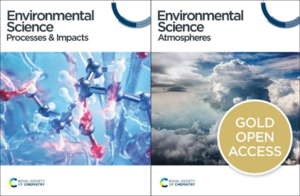We are delighted to announce that the Environmental Science: Atmospheres and Environmental Science: Processes & Impacts themed issue on Indoor Air Quality is now online.

Although we spend much of our time indoors, most research and public attention to date has focused on ambient air, as has policy action to reduce exposure to, and the health impacts of, air pollution. This has started to change.
This collection focuses on chemistry relating to indoor air quality, including:
- Studies advancing the field of environmental sciences in surface chemistry, microbial activity, photochemistry, and exposure science.
- Studies using both theoretical and experimental methods.
- Various approaches including instrument development, measurements, modelling and consideration of policy and health impacts of indoor air quality.
The collection is complemented by an editorial written by the Editors-in-Chief and the Royal Society of Chemistry’s Policy and Evidence team.
It includes:
Editorial
Introduction to indoor air quality
Neil M. Donahue, Kristopher McNeill, Daniel S. Korbel and Hannah G. Macdonald
Environ. Sci.: Atmos., 2023, Advance Article
Aerosol emissions and their volatility from heating different cooking oils at multiple temperatures
Sumit Sankhyan, Kayley Zabinski, Rachel E. O’Brien, Steven Coyan, Sameer Patel and Marina Vance
Environ. Sci.: Atmos., 2022,2, 1364-1375
Partitioning of reactive oxygen species from indoor surfaces to indoor aerosolsv
Glenn C. Morrison, Azin Eftekhari, Pascale S.J. Lakey, Manabu Shiraiwa, Bryan E. Cummings, Michael S. Warning and Brent Williams
Environ. Sci.: Processes Impacts, 2022,24, 2310-2323
Xin Xu, Hongwei Pang, Chao Liu, Kangyi Wang, Gwendal Loisel, Lei Li, Sasho Gligorovski and Xue Li
Environ. Sci.: Processes Impacts, 2022,24, 2237-2248
Nicole Cowell, Lee Chapman, William Bloss, Deepchandra Srivastava, Suzanne Bartington and Ajit Singh
Environ. Sci.: Atmos., 2023,3, 65-84
Near-source hypochlorous acid emissions form indoor bleach cleaning
Annastacia D. Stubbs, Melodie Lao, Chen Wang, Jonathan P. D. Abbatt, John Hoffnagle, Trevor C. VandenBoer and Tara F. Kahan
Environ. Sci.: Processes Impacts, 2023,25, 56-65
Leigh R. Crilley, Melodie Lao, Leyla Salehpoor and Trevor C. VandenBoer
Environ. Sci.: Processes Impacts, 2023, Advance Article
Investigation of indoor air quality in university residences using low-cost sensors
Rowzhon Afroz, Xinyang Guo, Chu-Wen Cheng, Ariel Delorme, Ryan Duruisseau-Kuntz and Ran Zhao
Environ. Sci.: Atmos., 2023,3, 347-362
Ruijie Tang and Christian Pfrang
Environ. Sci.: Atmos., 2023, Advance Article
Amirashkan Askair, Frank Wania and Arthur Chan
Environ. Sci.: Atmos., 2023, Accepted Manuscript
Acetaldehyde in the indoor environment
Tunga Salthammer
Environ. Sci.: Atmos., 2023, Advance Article
Human skin oil: a major ozone reactant indoors
Charles J Weschler and William W Nazaroff
Environ. Sci.: Atmos., 2023, Accepted Manuscript
We hope that you enjoy reading this collection of articles. Please get in touch if you have any questions about this themed collection or want to contribute to the growing work on indoor air quality.

